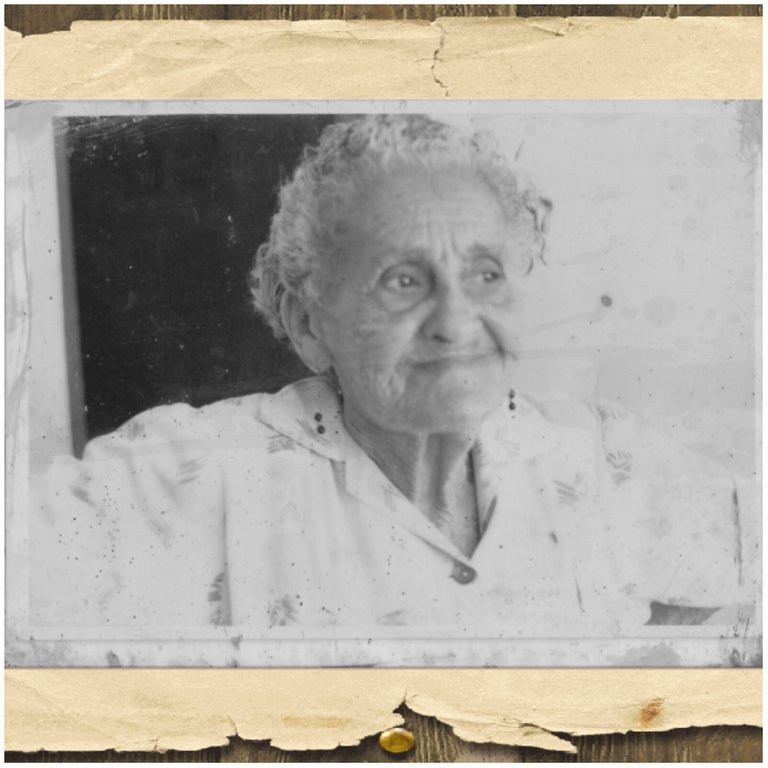Hello everyone.
I hope you are cool.

María Josefa Moya.
This Mrs. I call my attention because she is a person remembered with respect in interesting anecdotes and considered a cultural character by the mayor. His image rests on a mural together with other important personalities of the community such as doctors, painters, musicians and teachers.
According to what I am told was sought by many women when bringing their children to the world, families trusted incredibly in their hands and prayers when they were complicated births, saving many children and mothers from death, achieving with massages and prayers that babies they will settle to be born.
Her stories, although the most beautiful ones refer to the number of children she brought to the world, are also those of people who heal with prayers of diseases where, according to medicine, she had not achieved anything, the number of infants her parents brought to her. to free them from an evil eye that they had thrown out and how much sought to remove souls from purgatory by the large number of prayers he knew and his faithful attendance at funerals and novenarios.
They tell their great-grandchildren that Maria Josefa, knew many prayers to get evil spirits, clean hexes and all kinds of evil cast, so many that at the time of his death could not die until another healer came to get the prayers, I asked what it meant to take prayers to which they answered me: that is that in order to die she had to pass on to another person with knowledge and proper attitude the prayers for her learned.
After listening to this story I started to read and investigate a little about midwives, midwives, midwives and healers as they are characters that are not appreciated almost in this modern age and unknown by people like me who have come to live in cities like the beautiful but complicated and battered Caracas. I know that in some countries, natural births are being promoted with midwives studied in universities, something that at that time they learned with the practices and teachings that were imparted orally by the most experienced and elderly matrons.
Of the first Matrona mentioned in a writing, it was in the bible, it was called Debora and it was a woman from Palestine, also in the apocryphal gospel of Santiago, the moment in which two midwives Salome and Zelomí are required by José for the birth of Mary but when she arrived, Jesus was born.
In Egypt, Greece and Rome, they venerated Gods related to midwives.
EGYPT:
HEKET: Goddess midwife, who attends the delivery and drives away the dangers.
GREECE:
PHAINARETÉ or FÉNARETA: Midwife in Athens and mother of Socrates
AGNODIKÉ: midwife and first gynecologist in Athens, who had to disguise herself as a man in order to study and attend births, since for her time it was forbidden for women to attend childbirths. When she was discovered, she was put on trial and won by the recognition of women who attended referring to how well he performed his work.
ROME:
LUCINA: Goddess who was in charge of helping women during childbirth.

Matron.
In the middle ages, magic and witchcraft were associated with attendance at birth, the church pursued everything that for them was considered witchcraft although it was not and as a consequence of these there were matrons condemned to die at the stake accusing them of witchcraft.
At this time a matron had to meet a profile to not be considered a witch:
Being: Discreet, Cheerful, Experienced, Good manners, Strong, Delicate, Widowed if possible, Mother, Good Christian, Thin hands, Long fingers, Age 45-50.
By that time, the pain of childbirth was considered a just divine punishment and activity that was performed to relieve them was a sin and some midwives were taken to the stake for trying to calm these pains, as happened to Euphanie Macalyane in Scotland and Epiphany of Domeño in Spain.
Since very remote times there are midwives, midwives or midwives as you can read but it is also observed that they were not always valued or seen.

Matron condemned to the stake.
As for the healers and rezadoras I can tell you this:
The healers are people who cure diseases, ailments, bad eyes and sprains, with prayers, plants, baths, poultices of some grass and massages, also known in some places as shamans. And the rezadoras, are characters that like the healers exist from very remote times and is a clear manifestation of the religious culture of the population that seeks the salvation of the souls in each of their prayers in funerals, novenarios and days of deceased , to entrust them to God, these are women who usually meet as a group and attend as funeral and novena exist for their locality, today they are still present in towns like the one I live.
Another particular detail that I discovered was the weeping women or mourners, women who are paid to mourn the deceased in their wake, this custom comes from a Jewish rite that was used to express forcefully the pain of the people of the devastation of Judea.

Crying or plaintive
Well community Steemit I hope you have liked my writing, we read in an upcoming publication.
Chaito.